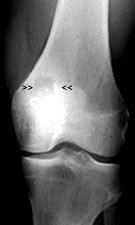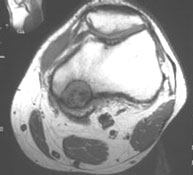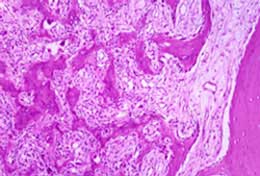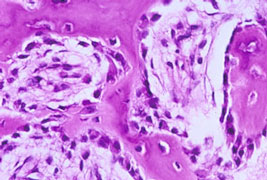|
|
|
Case # 19
|
Typical Clinical Presentation:
|
|
A 21-year-old male with a 6-month history of dull pain in the knee that was not relieved
by aspirin.
|
|
|
|
Characteristic Radiological Findings:
|
|
|

|
-
Plain radiograph shows a well circumscribed, low metaphyseal, radiolucent lesion containing
matrix-type radiodensities. Note the absence of a sclerotic rim.
|
|
|

|
-
MRI film demonstrates eccentric location and cortical expansion.
|
|
|
|
Pathological Findings: :
|
|
|

|
-
The microscopic features resemble those of osteoid osteoma. Osteoblasts and osteoclast-like giant
cells rim interconnected spicules of osteoid and woven bone. The intervening fibrous stroma shows prominent vascularity.
|
|
|

|
-
There is no significant cellular atypia.
|
|
|
Diagnosis: Osteoblastoma
|
|
Salient Points (Benign Osteoblastoma and Aggressive Osteoblastoma)::
|
-
Osteoblastoma is a rare bone-producing neoplasm that closely resembles
osteoid osteoma on microscopic examination. However, there are significant
differences between the two. By definition, all osteoblastomas are larger than 1.5cm.
They are slowly and progressively growing neoplasms. Although any bone may be involved,
osteoblastomas tend to arise in the axial skeleton, involving the spine and the sacrum in
about 40% of cases. The second most frequent site is the mandible, followed by other
craniofacial bones (Dorfman HD, Czerniak B. Bone Tumors. 1998). Unlike osteoid osteomas,
osteoblastomas do not produce prostaglandin/prostocyclin-mediated tissue reaction.
-
Peak incidence is in the second and third decades of life.
-
The term "aggressive osteoblastoma" is applied to large, locally destructive lesions that mimic a low-grade osteosarcoma on microscopic examination.
|
|
-
Characteristically, aggressive osteoblastomas have atypical and mitotically active,
epithelioid osteoblasts. But in contrast to osteosarcoma, the tumor shows no atypical
mitoses and no evidence of infiltrative growth, or sarcomatous stromal changes.
|
-
Clinical Behavior. Osteoblastomas may grow to a considerable size and produce bone
expansion and cortical destruction. Recurrences are common and occur in about 20% of cases.
Metastases are not a feature of osteoblastomas.
|

Reprinted with permission from Dorfman HD, Czerniak B: Bone Tumors. Mosby, Inc, 1998
|
|
|
|
Available publications for the topic:
Osteoblastoma
|
|
Selected References::
|
-
Dorfman HD, Weiss SW: Borderline osteoblastic tumors: Problems in the differential diagnosis of aggressive osteoblastoma and low-grade osteosarcoma. Semin Diagn Pathol 1:215, 1984
-
Bertoni F, Unni KK, McLeod RA, et al: Osteosarcoma resembling osteoblastoma. Cancer 55:416, 1985
|



